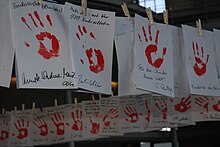Red Hand Day
| Red Hand Day | |
|---|---|
 Red Hand Day logo | |
| Official name | International Day against the Use of Child Soldiers |
| Date | February 12 |
| Frequency | annual |
| Part of Child soldiers |
| Main articles |
|---|
| Issues |
| Instances (examples) |
|
| Legal aspects |
| Movement to end the use of child soldiers |
On Red Hand Day or the International Day against the Use of Child Soldiers,
Background
Definition
The Paris Principles define a child associated with an armed force or group as:
...any person below 18 years of age who is or who had been recruited or used by an armed force or armed group in any capacity, including but not limited to children, boys, and girls, used as fighters, cooks, porters, messengers, spies or for sexual purposes. The United Nations General Assembly approved the document. It does not only refer to a child who is taking or has taken a direct part in hostilities.[3]
Current situation
Due to the widespread military use of children in areas where armed conflict and insecurity prevent access by UN officials and other third parties, it is difficult to estimate how many children are affected.[4] In 2017 Child Soldiers International estimated that several tens of thousands of children, possibly more than 100,000, were in state- and non-state military organizations around the world,[4] and in 2018 the organization reported that children were being used to participate in at least 18 armed conflicts.[5]
As of 2017[update], the UN list of countries where children are known to be used in armed conflict situations on the agenda of the Security Council includes:
Since 2008
Child soldiers and the law
Children aged under 15
The Additional Protocols to the 1949 Geneva Conventions (1977, Art. 77.2),
Children aged under 18
Most states with armed forces are also bound by the higher standards of the Optional Protocol on the Involvement of Children in Armed Conflict (OPAC) (2000) and the Worst Forms of Child Labour Convention (1999), which forbid the compulsory recruitment of those under the age of 18.[11][12] OPAC also requires governments that still recruit children (from age 16) to "take all feasible measures to ensure that persons below the age of 18 do not take a direct part in hostilities". In addition, OPAC forbids non-state armed groups from recruiting children under any circumstances, although the legal force of this is uncertain.[13][14]
Movement to end the military use of children
The military use of children has been common throughout history; the practice has only met with informed criticism and concerted efforts to end it in recent decades.[15] Many international organizations are active against the use of children as soldiers. These organizations include, for example, Amnesty International, Child Soldiers International, the International Red Cross and Red Crescent Movement, Terre des hommes, and the United Nations Child Fund (UNICEF).[citation needed]
Red Hand campaign

Since 2002, nations and regional coalitions from around the world have been holding events on February 12, Red Hand Day, to draw attention to the issue and encourage steps to end the use of children for military purposes.[16] The date reflects the entry into force of the OPAC treaty.[17]
For example, in 2008, children and teenagers initiated a campaign to collect as many red hand-prints as possible to present to the United Nations on Red Hand Day.[
See also
- History of children in the military
- Optional Protocol on the Involvement of Children in Armed Conflict
Notes
- ^ "On International Day, UN demands end to use of child soldiers in conflict". United Nations Office of the Special Representative of the Secretary-General for Children and Armed Conflict. February 12, 2015. Retrieved February 12, 2023.
- ^ About Red Hand Day Red Hand Day website
- ^ UNICEF (2007). "Paris Principles: Principles and guidelines on children associated with armed forces or armed groups" (PDF). Retrieved January 13, 2018.
- ^ a b Child Soldiers International (2017). "How many children are used for military purposes worldwide?". Retrieved January 25, 2018.
- ^ Child Soldiers International (2018). "Child Soldiers World Index". childsoldiersworldindex.org. Retrieved March 29, 2018.
- ^ a b United Nations Secretary-General (2017). "Report of the Secretary-General: Children and armed conflict, 2017". United Nations. Retrieved January 24, 2018.
- ^ World map, Child Soldiers International
- ^ "Hope and concern after results UN Report". War Child. Archived from the original on July 24, 2012.
- ^ International Committee of the Red Cross (1977). "Protocols additional to the Geneva Conventions of 12 August 1949" (PDF). Retrieved January 28, 2018.
- ^ "Rome Statute of the International Criminal Court (A/CONF.183/9)" (PDF). 1998. Retrieved March 22, 2018.
- ^ Child Soldiers International (2017). "International laws and child rights". Retrieved January 25, 2018.
- ^ International Labour Organization. "Ratifications of C182 – Worst Forms of Child Labour Convention, 1999 (No. 182)". ilo.org. Retrieved January 30, 2018.
- ^ Geneva Call (2012). "Engaging nonstate armed groups on the protection of children: Towards strategic complementarity" (PDF). Retrieved January 28, 2018.
- ^ Child Soldiers International (2016). "A law unto themselves? Confronting the recruitment of children by armed groups". Retrieved January 19, 2018.
- ^ Eigen, L D (November 3, 2009). "Child Soldiers Are Unfortunately Nothing New". Scriptamus. Retrieved February 12, 2018.
- ^ Coalition to Stop the Use of Child Soldiers. Archived from the originalon July 13, 2010.
- ^ "Optional Protocol to the Convention on the Rights of the Child on the Involvement of Children in Armed Conflict". ohchr.org. 2000. Retrieved March 22, 2018.
- Coalition to Stop the Use of Child Soldiers. February 12, 2009. Archived from the original(PDF) on July 13, 2010.
- ^ "UN Secretary-General Pledges to "Stamp Out" Use of Child Soldiers". Human Rights Watch. February 13, 2009.
External links
- Child Soldiers World Index (2018), child soldier world map and statistics
- Red Hand Day – official website
- Red Hand Day 2009 – press release photos
